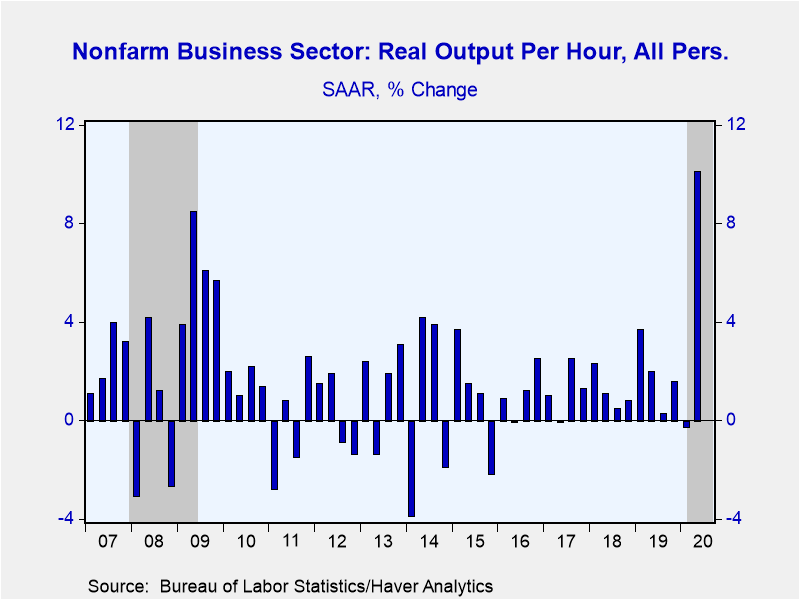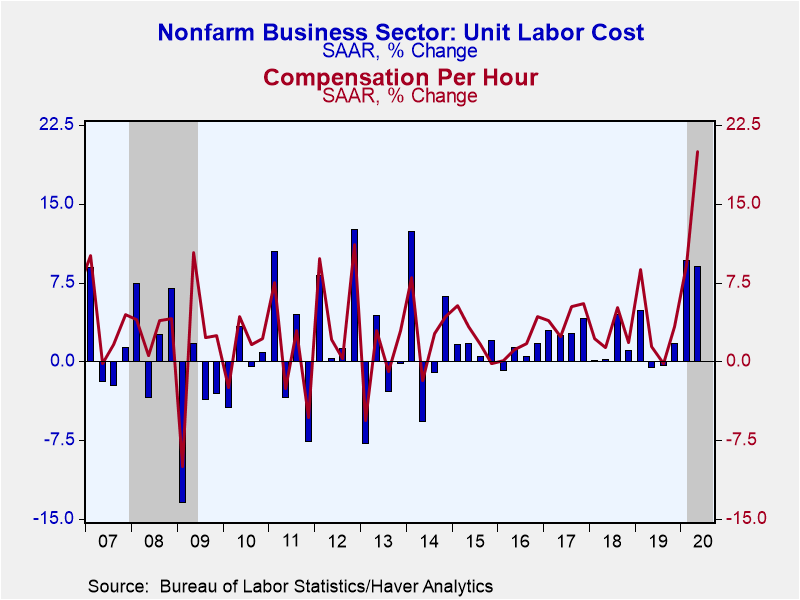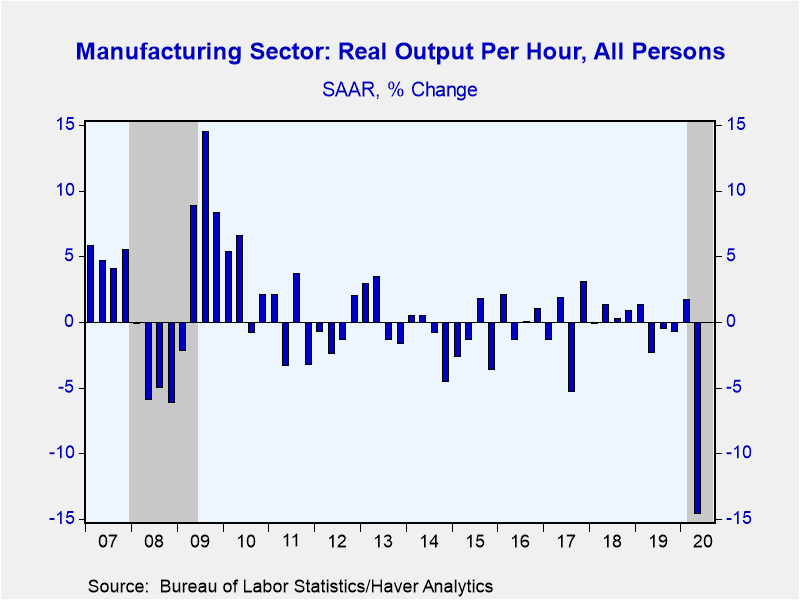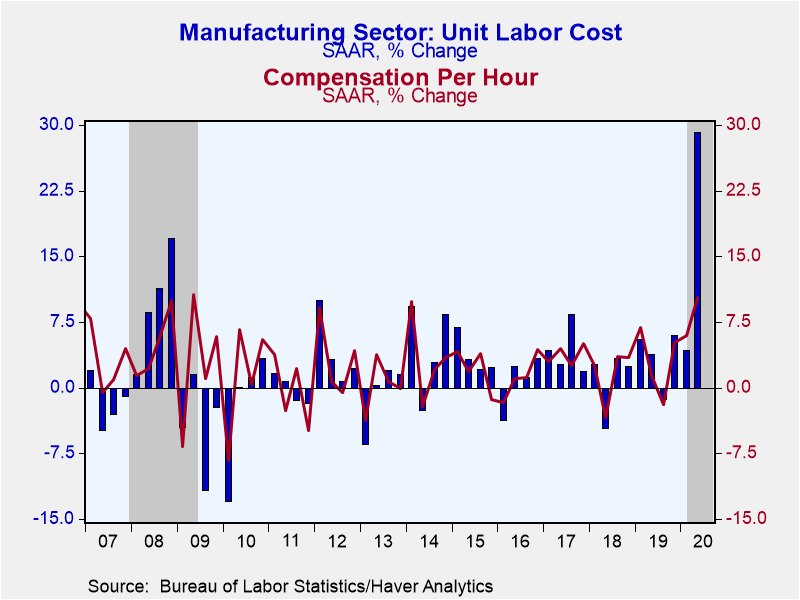 Global| Sep 03 2020
Global| Sep 03 2020U.S. Productivity Revised Up, Unit Labor Costs Revised Down for Q2'20
by:Sandy Batten
|in:Economy in Brief
Summary
• Output per hour growth revised up on a smaller fall in output than initially estimated. • The rise in unit labor costs revised down on stronger productivity and slightly weaker compensation growth. In the second quarter of 2020, [...]
• Output per hour growth revised up on a smaller fall in output than initially estimated.
• The rise in unit labor costs revised down on stronger productivity and slightly weaker compensation growth.
In the second quarter of 2020, nonfarm business sector productivity increased 10.1% q/q SAAR--a 2.8%-point upward revision from the preliminary estimate of 7.3%. This was due mainly to a 1.8%-point upward revision to output. Unit labor costs increased 9.0% q/q, a smaller increase than previously reported (12.2%). This downward revision was largely due to the upward revision to productivity. Hourly compensation was revised down 0.4%-point, from a 20.4% increase to a 20.0% increase.
Manufacturing sector productivity for the second quarter of 2020 was revised up to a decrease of 14.6% q/q SAAR from a previously-reported decrease of 15.5%. Durable manufacturing productivity was also revised up, to a decline of 26.9%; nondurable manufacturing productivity was revised down slightly, to a decline of 5.1%. Total manufacturing unit labor costs increased 29.1% in the second quarter of 2020, rather than increasing 31.1% as previously reported.
The 10.1% q/q increase in nonfarm business sector labor productivity in Q2 was the largest quarterly increase since the first quarter of 1971, when output per hour increased 12.3%. The declines in both output and hours worked in the second quarter of 2020 were the largest in these series, which begins in 1947 Q1. The 20.0% increase in hourly compensation in Q2 was the largest increase in the series which also begins in 1947. Moreover, labor's share--the percentage of current-dollar output that accrues to workers in the form of compensation--increased to 59.8% in the second quarter, the highest level since 2008 Q4 (60.1%).
The productivity and labor cost figures are available in Haver's USECON database.
| Productivity & Costs (SAAR, %) | Q2'20 (Rev) | Q2'20 | Q1'20 | Q2 Y/Y | 2019 | 2018 | 2017 |
|---|---|---|---|---|---|---|---|
| Nonfarm Business Sector | |||||||
| Output per Hour (Productivity) | 10.1 | 7.3 | -0.3 | 2.8 | 1.7 | 1.4 | 1.2 |
| Compensation per Hour | 20.0 | 20.4 | 9.2 | 7.8 | 3.6 | 3.4 | 3.5 |
| Unit Labor Costs | 9.0 | 12.2 | 9.6 | 4.9 | 1.9 | 1.9 | 2.2 |
| Manufacturing Sector | |||||||
| Output per Hour (Productivity) | -14.6 | -15.5 | 1.7 | -3.7 | 0.1 | 0.3 | -0.4 |
| Compensation per Hour | 10.3 | 10.7 | 6.0 | 4.8 | 2.9 | 2.1 | 3.2 |
| Unit Labor Costs | 29.1 | 31.1 | 4.2 | 8.9 | 2.8 | 1.8 | 3.6 |
Sandy Batten
AuthorMore in Author Profile »Sandy Batten has more than 30 years of experience analyzing industrial economies and financial markets and a wide range of experience across the financial services sector, government, and academia. Before joining Haver Analytics, Sandy was a Vice President and Senior Economist at Citibank; Senior Credit Market Analyst at CDC Investment Management, Managing Director at Bear Stearns, and Executive Director at JPMorgan. In 2008, Sandy was named the most accurate US forecaster by the National Association for Business Economics. He is a member of the New York Forecasters Club, NABE, and the American Economic Association. Prior to his time in the financial services sector, Sandy was a Research Officer at the Federal Reserve Bank of St. Louis, Senior Staff Economist on the President’s Council of Economic Advisors, Deputy Assistant Secretary for Economic Policy at the US Treasury, and Economist at the International Monetary Fund. Sandy has taught economics at St. Louis University, Denison University, and Muskingun College. He has published numerous peer-reviewed articles in a wide range of academic publications. He has a B.A. in economics from the University of Richmond and a M.A. and Ph.D. in economics from The Ohio State University.










